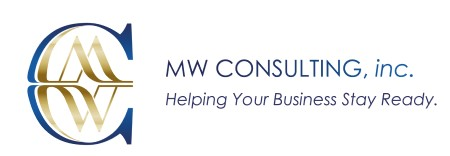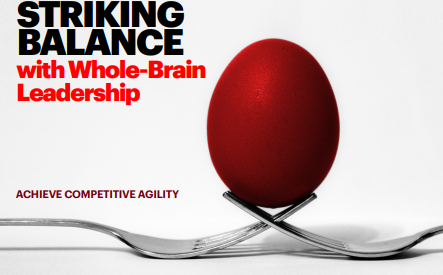JUNE 5, 2019 RESEARCH REPORT
New Rules of Engagement for the C-suite
- The complexity of today’s disruption is challenging executives to transform their companies, their C-suite and themselves personally.
- The C-suite must work collaboratively with influential, purpose-driven “Pathfinder” customers and employees, a group that values a well-rounded, whole-brain skillset in leaders.
- The opportunity for the C-suite lies in closing the gap between the skills and behaviors Pathfinders expect of leaders, and what the C-suite deems important.
- C-suite leaders adopting a whole-brain approach see a positive bottom-line impact and realize on average 22% higher revenue growth and 34% higher profitability growth.
- Three accelerators will help C-suite leaders achieve whole-brain thinking to drive higher-value problem solving.
Feeling the Pressure
Exponential leaps forward in consumer expectations and innovation are forcing massive changes at a lightning fast pace across industries everywhere. The combinatorial impact of these disruptive forces — along with the exploding demand for machine learning-powered analytics and the plummeting cost of data on one side, and the need for human-centered approaches to tap into the full potential of customers and employees on the other — is fueling this unstoppable wave of evolution.
Our new global research homed in on the ways in which C-suite leaders need to respond. At stake for these leaders: retaining relevance and credibility as individual leaders and as a leadership team.
Business leaders are under pressure now more than ever, especially leaders at the top. For their organizations to not only succeed — but to truly thrive — in this ever-complex age of disruption, C-suite executives must put forth a bold, new and different response.
The Avalanche of Disruption
Pressures are compounding and converging on the C-suite like never before.
85%
of C-suite executives report that the disruptive impact of new technologies is increasing in intensity.
74%
of C-suite executives report that the disruptive impact of shifting customer demands has increased in the past three years.
72%
report that the disruptive impact of new market entrants has increased.
62%
report investors are among their most disruptive stakeholders.
49%
report that employees are among their most disruptive stakeholders.
Embracing the Positive Agents of Change
Our research shows there are three groups of employees and customers that company leaders are accustomed to adeptly managing — we’ve labeled them the “Agitators,” the “Disenfranchised” and the “Indifferent.” Then we have the “Pathfinders,” a new group we identified that is remarkable for both their characteristics and influence.
“Pathfinders” are of particular relevance. This group is framed by self-perceived empowerment and motivations, and by their belief that they can effect change within companies they work for and buy from. Instead of being viewed only as an additional destabilizing force, this “supergroup” of employees and customers can be positive agents of change to be embraced. They comprise a third of the 11,000+ employees and customers we surveyed globally.
And yet, they are a considerably varied group exhibiting a wide array of notable characteristics. Neither entirely Millennials nor Gen Zs, Pathfinders defy categorization by conventional demographic means. Rather, this group is defined more by a unique mindset than simple demographics.
If C-suite executives engage Pathfinders, they will find that this unique group of allies has the power to accelerate and guide the type of change leaders must make to continue to remain competitive.
Market shifts and technological advances are compounded for C-suite leaders by new disruptors.
The Super Group with Super Powers
The C-suite is not oblivious to the power and potential of Pathfinders. Nearly three-quarters of this “supergroup” believe they have the potential to destroy business value if their expectations are ignored. That’s the bad news. The good news: Pathfinders possess significant influence. As employees, they are twice as likely to be on the fast track to leadership and have critical skills. They are also 67% more likely to buy from companies who contribute to society. By taking the lead from the Pathfinders, the C-suite can make important new allies and provide the on-ramp to the change they need to position themselves and their companies for success.
Expectations for the C-suite: Whole-Brain Leadership
Our research indicates that Pathfinders are pushing the C-suite to find new ways to lead, grow and sustain their organizations — demanding a new type of leader to engage their passion, principles and capabilities. Their expectation? Leaders who have a strong balance across analytics-led and human-centered skills.
This approach blends what’s traditionally been considered “left-brain” (scientific) skills that draw on data analysis and critical reasoning with “right-brain” (creative) skills that draw on areas like intuition and empathy. Bringing the two together intentionally to drive deeper levels of problem solving and value creation is critical.C-suite teams that proactively embrace and promote whole-brain approaches in their companies yield better financial outcomes than those that don’t.
But the majority (89%) of today’s C-suite leaders hold business school, science, or technology degrees and have honed “left brain” skills—like critical reasoning, decision-making and results-orientation. Numbers. Data. Stats. The science of management, rooted in reasoning and proof points. This has served them well, and these capabilities will always be vital. But they are no longer sufficient.

Whole-brain Skills: Closing the Gap
The C-suite values a whole-brain skillset, but less than Pathfinders do. This is where the C-suite can close the gap in what’s expected of them (see the gap illustrated below for the different countries in our research).
In fact C-suite leaders themselves (65%) say their “right-brain” skills are weakest and recognize the need to strengthen their right-brain skills — including empathy and intuition — for a well-rounded whole-brain approach.
USA
The beginning of a shift is underway. While only 8% of C-suite leaders report using a whole-brain approach today in their companies, 82% say they plan to leverage a whole-brain approach in the future.
8%
use a whole-brain approach today
82%
intend to use a whole-brain approach in the next 3 years
Not only is adopting a progressive whole-brain leadership approach good for building diversified thinking and decisions, it’s also good for the bottom line.
Case in point: Accenture Strategy’s research showed a correlation with stronger financials on average over a 3-year period for those companies using a whole-brain approach today. That’s 22% higher revenue growth and 34% higher profitability (EBITDA) growth.
22%
higher revenue growth
34%
higher profitability (EBITDA) growth

Building tomorrow’s whole-brain leaders
Effective leadership requires mastering and blending both left- and right-brain thinking. Northwestern University’s McCormick School of Engineering embraces this imperative to do more than educate great engineers – they are building tomorrow’s whole-brain leaders who will help take the world in a whole new direction. They empower their students to become whole-brain engineers by integrating elements of left-brain thinking—analysis, logic, synthesis, and math—with the kind of high-level right-brain thinking that fosters intuition, metaphorical thought, and creative problem solving.
The National Academy of Engineering recognized Dean Julio M. Ottino for the development of Northwestern’s whole-brain engineering philosophy with the 2017 Bernard M. Gordon Prize for Innovation in Engineering and Technical Education.
Make the Plan, Work the Plan
The path forward is clear.
1. Address the skills gap: Nine in 10 C-suite executives are beginning to take action by using organic and inorganic ways to tackle the skill gap in their midst. Over half of the executives surveyed report active reskilling efforts aimed specifically at the C-suite and 46% are bringing in new talent from outside their organization.
2. Redefine traditional leadership: Harnessing the power of the Pathfinder group is essential. By embracing them, granting their voices access to traditional “leadership only” channels and acting on their insights, the C-suite will gain allies and re-credentialize their leadership. And because Pathfinders are two times more likely to be motivated to give their best to their employer, and twice as likely to choose a more expensive brand because they prefer what it stands for, the entire company will benefit from leveraging these natural agents of change.
3. Drive change deep and wide: Getting this right is a balancing act. The C-suite must build these balanced skills and use them at both the organizational and individual level. This will enable them to leverage a whole-brain approach to solve the higher value problems that today’s combinatorial effect of disruption presents. And by leading from the front, they will ingrain data-led and human-centered skills into the organization as the new norm, paying dividends short and long term and enhancing competitiveness.

About the Research
The Whole-Brain Leadership: The New Rules of Engagement for the C-suite report from MW Consulting, Inc. Strategy is based on insights from research including interviews with 200 C-suite executives from France, Germany, Italy, Spain, the United Kingdom and the United States; survey responses from more than 11,000 employees and consumers in China, France, Germany, Italy, Spain, the UK and the US; and in-person focus groups in Spain, the UK and US. The study found that leadership teams that actively acquire, deploy, demonstrate and embed diversified whole-brain thinking across the organization fare better financially than those that don’t.


